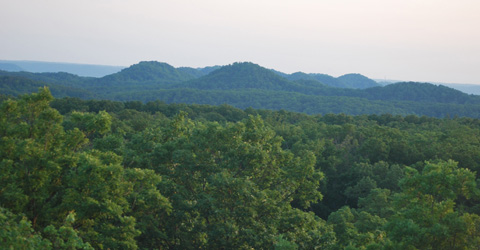Two mountain ranges on two continents. Facing many of the same 2st century issues.
This September, four professors from Ohio University will travel to the Carpathians/Appalachians International Conference 2013 at the Vasyl Stefanyk Precarpathian National University (PNU) in Ivano-Frankivsk, Ukraine. The journey to the Carpathians will take place from Sept. 21 to 28 and include a stay at a conference center in the little mountain village of Mykulychyn.
The conference will explore similarities between the Appalachian and Carpathian cultures, economies, and histories. For the Ohio University delegation, Dr. Geoff Buckley, Professor of Geography, will first give a presentation on the environmental and social impact of mountaintop removal mining. Dr. Bernhard Debatin, Professor for Multimedia Policy, will then talk about the public debate on hydraulic fracturing, highlighting the difference between optimistic industry projections and the “hidden costs” of fracking for residents, the environment, and the tax payer. In her presentation, Dr. Michele Morrone, Professor of Social and Public Health, will explore effects of fracking on human health and the scientific uncertainty surrounding this issue. A cultural-linguistic comparison of the Appalachian and Carpathian Highlands is the focus of a paper by Dr. Michelle O’Malley, Professor of Linguistics, with a particular emphasis on the separateness of these cultures from contemporary mainstream culture.
The conference will bring together a total of 20 researchers from American Universities and a similar number of researchers from various European countries, as well as the Ukrainian hosts. More information and the program can be viewed at the Facebook page of the conference at Carpathians/Appalachians International Conference 2013.
Geoff Buckley: Moving Mountains in Appalachia: Life in the Shadow of MTR Mining (Session B)
Passed in 1977, the Surface Mining Control and Reclamation Act (SMCRA) is a federal law that governs the operation and restoration of mine sites in the United States. A guiding principle of the legislation is that lands that have undergone surface mining should be restored to their “approximate original contours” (AOC). However, an exception known as the AOC variance permits a particularly devastating form of surface mining to take place in the mountains of central Appalachia. Known as mountaintop removal (MTR), it is especially prevalent in Kentucky, Tennessee, and West Virginia. The process entails clear-cutting native timber, using explosives to loosen soil and dislodge underlying rock, and then dumping this “fill” material in the headwaters of local streams. Once a seam of coal is exposed in this manner, power shovels and bulldozers are used to extract it and haul it away. Where multiple layers of coal exist, the process is repeated. To date, hundreds of mountains in central Appalachia have been leveled and thousands of miles of streams damaged, all in the name of producing “cheap” coal. In this paper, I weigh the perceived economic benefits of using mountaintop removal techniques against the social and environmental costs the practice exacts on local inhabitants and communities. More specifically, I use interview data collected from residents in southern West Virginia to provide a true accounting of this destructive process.
Bernhard Debatin: Hydrofracking: Panacea or Pandemic? (Session B)
Fracking has been called a “game changer” for U.S. energy independence and economic revival. The extraction of shale gas and oil has brought a new fossil fuel boom. The Marcellus Shale in Appalachia is a significant gas producer; the Bakken Shale (North Dakota) and the Barnett Shale (Texas) are major oil producers. The United States already has overtaken Russian gas production and is expected to surpass Saudi Arabia and Russia as the world’s top oil producer by 2017. The gold-rush mood is contagious: Many European countries are hoping to exploit their formerly unrecoverable shale gas and oil fields. Poland is the leading force with shale gas production to begin in 2014. Other countries, including the Ukraine, are following. However, industry projections ignore that energy demands keep climbing and that shale hydrocarbons are a transient energy source with a steep decline rate. Moreover, as with any commercial technology, profitability is relative to the amount of externalized costs. Externalized side effects of fracking become increasingly visible, ranging from the significant air and water pollution due to lax regulations, to careless disposal of toxic fracking waste, to the disruption of communities in the fracking fields. My presentation will explore the public debate between lofty predictions of a new oil and gas plethora on the one hand, fueling the ideology of untrammeled fossil energy consumption, and the reality of externalizing costs at the expense of people and nature in environmental sacrifice zones on the other hand.
Michele Morrone: Scientific Uncertainty and the Public Debate about Hydraulic Fracturing (Session B)
As hydraulic fracturing (fracking) for natural gas extraction expands in the United States, questions are being raised about its possible environmental and human health effects. Scientific research attempting to quantify the impacts is in its infancy with few peer-reviewed, published studies and little empirical evidence. Nevertheless, proponents and opponents of the fracking invoke science when presenting their arguments to the public. In some instances the messages are directly contradictory even though they are based on the same published study. In other instances anecdotal evidence is portrayed as valid scientific research. Even though empirical evidence related to environmental and health impacts is uncertain, incomplete, and inconclusive at this point in time, anecdotal evidence related to public perception identifies important information related to public opinion on the process. According to the World Health Organization, “Health is a state of complete physical, mental, and social well-being and not merely the absence of disease or infirmity.” In using this definition, hydraulic fracturing appears to be affecting public health as evidenced by mounting debate that is taking place in local communities. Nevertheless, current public opinion polls indicate that Americans are less concerned about the environment than the economic development possibilities from developing domestic energy resources. The state of the economy is contributing to the potential for hydraulic fracturing to be a defining environmental issue in the United States in general and Appalachia in particular.
Michelle O’Malley: Appalachia and the Carpathians: Comparing Highland Regions from a Cultural-linguistic Perspective (Plenary B)
This presentation introduces participants to the cultural and historical aspects of Appalachia and how these components are evident in the language, lifestyle, and music of the region. This introductory session also seeks to highlight the similarities between the people of Appalachia and the people of the Carpathian Mountains (Hutsuls) with an eye toward their separateness from contemporary culture. Emphasis will be placed on cultural beliefs that, while serving to maintain a valued way of life, often perpetuate difficulties for Appalachian people who leave their home regions for educational, financial and/or personal reasons. It is expected that parallels between Appalachia and the Carpathians will be identified and discussed thereby facilitating question and answer sessions.


















Comments